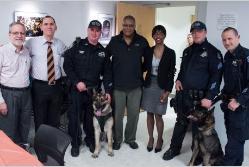This section of the SUNY Empire website is no longer being updated.
View current SUNY Empire Stories.
April 20, 2016
NYPD Transit Bureau Canine Unit Meets with Students and Faculty for a Study Group

In a classic exercise of courtesy, professionalism and respect, the members of the New York Police Department’s Transit Bureau Canine Unit met with a group of SUNY Empire State College students and faculty to discuss the unit’s role and responsibilities in keeping the community safe.
The study group was set up as a learning opportunity for students, particularly for those enrolled in the college’s Community and Human Services area of study. Most Community and Human ServiceS students concentrate in criminal justice or human services.
According to David Gechlik, an associate professor in Community and Human Services who coordinated this group, students learned about some of the new counterterrorism initiatives the NYPD is currently involved with and about the skills and competencies necessary to work with in the K-9 unit.
“When students engage in critical thinking and participate in discussions, they tend to be more likely to succeed in their studies,” said Gechlik.
Students learning in the college’s 11 other areas of study also were invited to attend and participate.
“Study groups are a critical mode of learning in my education,” said Michael Bailey, a current student enrolled in the college’s Business, Management and Economics area of study. Bailey also photographed the study group. “As a mode of learning, study groups provide the opportunity for dialogue that is mutually inclusive among students, faculty and, in this case, the NYPD. Group studies become ‘venues’ that enable opinion or ideology to be debated on the merits. Faculty and outside experts provide factual accuracy, which is contextually grounded within a wide range of diverse life experiences.”
Students were able to observe the officers and their dogs searching for various hidden items with enthusiastic energy and success. NYPD officers provided a role-playing demonstration, where officers commanded their dogs to “take down” a dangerous individual, played by another officer.
Bailey said that another significant benefit to participating in the study group was that he got to know the police officers as individuals.
“The ability of the officers to be at peace knowing they may have to sacrifice their lives to prevent or deal with terrorism forced me to evaluate my biases towards the NYPD,” said Bailey. “I was reminded of their humanism beyond the uniform that is lost to politics, a sensationalist media story, or cases of institutionalized racism. I was humbled in remembering that the officers are mothers and fathers and sons and daughters, who have lives and personal aspirations.”
The study group took place March 28 at the college’s location at 325 Hudson St., Manhattan. Lt. John Pappas, commanding officer of the canine unit, Sgt. Randy Brenner and his K-9-partner, Shaunie, and Officer Vincent Tieniber and his K-9-partner, Champ, represented the NYPD.
Shaunie is named for Brenner’s former NYPD partner Shaun Mahoney, who died of 9/11-related cancer. Both dogs are German shepherds.
More than 50 students and members of the college’s faculty participated in the learning exercise.
As the result of students’ attendance and participation, additional study groups with the NYPD K-9 unit are planned for Manhattan and at 177 Livingston St., the college’s Brooklyn location, for the upcoming fall term.
According to Pappas, the K-9 unit serves five NYPD divisions:
- narcotics, where officers and dogs search crime scenes and other places for hidden drugs
- bomb squad, where officers and dogs search specific areas and vehicles for explosive devices
- emergency service, where officers and dogs respond to calls
- transit, where dogs accompany their officers and ride public transit systems in the city
- critical response command, where dogs are trained to detect the “vapor wake” of bombs and explosive devices in populated areas.
Belgian Malinois and German shepherds are used within the narcotics, bomb squad, emergency service and transit divisions. Labrador retrievers, referred to as “floppy-ears breeds” by the NYPD, are used in the critical response division.
Pappas said the addition of officers and dogs trained in vapor wake detection is a recent enhancement to the NYPD’s counterterrorism capabilities and he stressed the central role that the K-9 unit has had in aiding the city’s and New York state’s counterterrorism efforts in public-transit spaces.
While traditional bomb-sniffing dogs identify placed or stationary explosives, Labradors are trained to detect vapor wakes. These K-9 officers can detect mobile explosives up to 10 minutes after a person has left an area.
After detecting a vapor wake, officers and their dogs work with a broader NYPD team to track and apprehend potential suspects.
According to Pappas, representatives from the FBI, CIA and the city of Boston police department frequently visit to understand how best to replicate and implement K-9 units.
Representatives from parts of Europe, Israel and Palestine also have come to the city to consult with the NYPD’s K-9 unit prior to establishing their own units.
Dogs in the NYPD’s K-9 unit are each paired with a specific handler and then trained for at least one year.
Training consists of seven months detecting odors and handmade explosives and then a four-month period in patrolling.
Canines work between five and 10 years with their handlers before retiring.